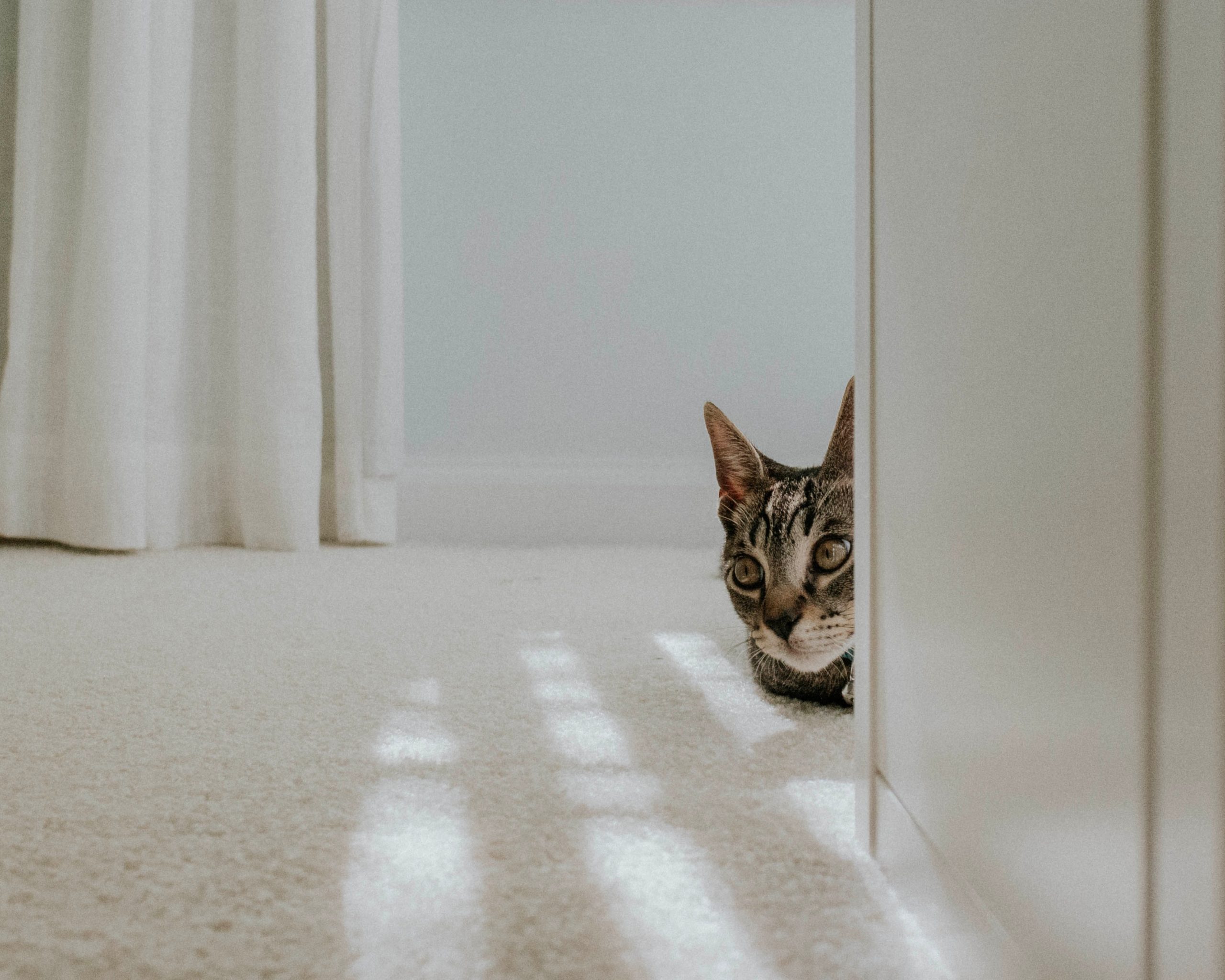IT’S BUSINESS AS USUAL. Click here TO FIND OUT MORE.
Flooring Knowledge
Whether you have a furry, fluffy or feathery friend, pet-friendly flooring is an important factor to consider for many Australians when purchasing new flooring for their home or office. At the start of 2020, RSPCA published an article stating there are over 29 million pets in Australia. This makes us one of the highest countries in the world to own pets. According to Jetstar’s Global Travel Survey, one in four Aussies miss their pets more than their family members while they're on holiday. Therefore pet-friendly flooring is an important consideration for Australian families, property owners and landlords. The most important things to consider when selecting pet-friendly flooring for your household is: Durability & longevity (overall strength & product life, as well as wear & tear) Stain resistance Cleaning & maintenance (easy clean & care) Scratch resistance Odour resistance Warranties If you have been in our showroom you might have seen our resident pet, Floyd. Our wool carpet has been personally tried and tested by Floyd and that’s how we know it will work for you and your pet. Carpet for Pet Owners Over the years, we have seen for ourselves how durable wool carpet truly is, even with pets. Wool carpet sets the standard for all carpet fibres. It stands the test of time like no other carpet fibre. Its superiority stems from the complexity of the fibre developed by mother nature to protect sheep in all weather conditions. When choosing the best flooring for your dog or cat, you should consider the benefits of wool carpets. The benefits of wool carpet: Wool is a 100% natural and renewable fibre Its soil-resistant, making it easy to clean Naturally improves air quality which reduces that “doggy” smell Hard-wearing it retains its look for longer and therefore more cost-effective If you're looking for a budget-friendly alternative, synthetic carpets don’t compromise on aesthetics to achieve the look of luxury for less. Nylon fibres are most popular when it comes to synthetic carpets due to their durability, stain-resistant qualities as well as affordability, making them the most suitable for households with kids and pets. Carpet Colours When it comes to selecting your new carpet colour many pet owners decide to select a carpet colour that is similar to the pet's fur, thereby assisting with the visibility of animal hair on the floor. Linoleum Flooring for Pet Owners Historically linoleum flooring has been used for heavy traffic commercial environments due to its exceptional durability. With the rise of eco-friendly and sustainable products, linoleum has become a popular choice for residential homes that are environmentally conscious. The reason being, it’s a sustainable product made from 97% natural raw materials, 72% rapidly renewable materials and 43% recycled content. The key raw materials used in the production include linseed oil, wood flour and jute. Because of its natural timber/rosin ingredients, it will continue to harden with age and can have a life expectancy of up to 40 years. Therefore due to its durability and longevity, it makes a classic choice for busy Australian homes with pets. Linoleum comes in a variety of different colours as shown by a select range of colours below. Linoleum is also versatile in the way you can select from a range of tiles, planks and sheets with some colours available in Australia and other from Europe. Examples of these styles can be seen below. Previous Next Vinyl Flooring Options for Pet Owners Whilst tiles can be too cold on your pet's paws, hardwood floors can be noisy on their claws, vinyl flooring is a fantastic alternative. It’s quiet and comfortable underfoot for both humans and animals alike, it also provides enough traction to prevent pets from slipping around. Is Vinyl Flooring Good for Pets? Vinyl flooring is a fantastic option for households with pets. It’s not only incredibly tough and resilient to wear and tear, but it’s also one of the easiest floors to keep clean. For allergy sufferers, it’s a great option as pet hair remains on the surface making it easy to remove by sweeping, vacuuming and mopping. In recent years vinyl planks have come a long way in terms of design, they are extremely stylish and an affordable alternative to timber floors. Vinyl flooring is a particularly great choice as specific products like the MiPlank range are incredibly low VOC and are free from any heavy metal substances, making it a safe flooring option for kids and fur babies alike. Things to look for in vinyl tile & plank floors: Wear resistance Durability Extremely easy care & clean Great warranties Cleaning and Maintenance Pet ‘accidents’ are inevitable, to ensure the best results and to have a chance of the stain not becoming permanent, it needs to be attended to promptly. Regular vacuuming at least once a week is also advised to keep the carpet looking fresh for longer. Here are a few tips for keeping your vinyl flooring in top condition with pets in the home. Keep your pet's nails trimmed. Use doormats at entrances to collect dirt and debris, especially useful after long muddy walks! Place a protective mat underneath any pet food and water bowls to catch any spillages. Clean up any spillages or “accidents” as quickly as possible to reduce the risk of staining.
Introducing MiPlank, a luxury vinyl plank collection by PolyFlor. With the Australian lifestyle in mind, this collection was carefully created by a team of expert interior designers that combines the latest trends and designs to create a premium look and feel. This luxury vinyl plank (LVP) collection features 15 authentic timber designs, each containing unique knot and grain details to replicate […]
Have you ever walked into a carpet retailer and been completely overwhelmed by the array of choices, well your not the only one. Whether you like a loop, twist, or plush pile carpet we have a selection of them all. As explained below there are several different carpet styles and carpet types available each with […]
Your home is an extension of your unique sense of style. Whether your style is contemporary, eclectic, modern or traditional, a custom sisal rug will suit. Sisal rugs have a beautifully textured feel and are an excellent choice for almost any room in your home. Creating the perfect sisal rug is as easy as 1,2,3. Select the style, border and custom size […]
Let your imagination run wild with our custom handmade rugs! Have you been searching for that perfect coloured wool rug, but haven’t been able to find it? Look no further! Introducing the Olbia Collection. Every rug from this collection is handcrafted using techniques developed over the 50-year period in which Tisca has been making traditional handwoven rugs. The Olbia Collection […]
On Saturday 15th May 2021 the Cross Carpets team was lucky enough to attend the sold-out “Everything is Possible” Gala Dinner held at The Star Gold Coast. The event raised a record $200,000+ for the Perry Cross Spinal Research Foundation (PCSRF) which will go towards their Intensive Rehabilitation Trial. This is the next critical step […]
As everyone knows, our lives are always busy, and time is one of our biggest enemies. There are never enough hours in the day. The lawns need mowing. The dishes need doing. The floor needs vacuuming. It’s never-ending and there are always more household duties to be done. Whether you’re working full time, looking after a newborn, or busy in life in general, a robot vacuum is the perfect solution […]
We are thrilled to announce the completion of the Walker Farm Project. This exciting collaboration took place in the Byron Bay Hinterland of New South Wales less than an hour south of the Gold Coast. Back in August 2020 when we jumped on board with The Designory, Sanctuary 28, and Marc & Co to produce […]
Did you know that the average person will spend 90,000 hours at work over their lifetime that’s equivalent to one -third of your life! Therefore, your time at work can have a massive impact on your overall life. Which makes it important to create a comfortable and enjoyable atmosphere for your customers and employees. No matter […]
Polyflor is set to launch a new floor cleaner onto the market for hard and soft surfaces on the 15th February 2021. Introducing Pureflor, a proudly Australian made product, specifically designed to be the most effective floor cleaning product available. These products contain only natural ingredients in a concentrated formulation, the Polyflor range is pH […]
Are you new to the world of flooring and don’t quite understand all the technical terminology? Not to worry, we have compiled a comprehensive list, you’ll be a pro before you know it! Axminster a traditional method of manufacturing carpet. Axminster carpet is when each tuft of yarn is woven and locked into place by […]
There is no question we all spend a large portion of our lives indoors, so it’s essential to consider the materials used in our homes and their impact on the environment as well as our health. Thankfully research and technology are continually evolving, which allows manufactures to create new products accordingly. Whether you’re building or […]
With your brand new carpet now installed, it’s important you know how to clean and maintain your carpet for the future. Looking after your carpet is vital! When you remove the dirt that leads to stains, you’re preserving the carpet’s original texture and increasing its lifespan. Considering the average Australian spends 83% of their life […]
As the saying goes, ‘out of sight, out of mind’, well this is the case for majority of people. Underlay is the most underestimated feature when purchasing new carpet. The importance of carpet underlay is vital! The time and money you spend on choosing a good quality underlay won’t be wasted. A good quality underlay […]
Are you looking for something a little more unique? Custom carpet is your answer. At Cross Carpets we offer custom wall to wall carpet in a variety of colours and designs to suit every Australian home. We work together with you to create a unique carpet that truly compliments your space and everyday living. All our […]
We’re thrilled to announce one of our suppliers, Cavalier Bremworth revealed last Friday they will be transitioning into an all wool and natural fibre company and as a stockist of their carpet we couldn’t be more excited. “Cavalier has always believed that wool is the best fibre for carpet and it is considered a global […]
“For the utmost in luxury, look no further than the Bremworth Collection.” At Cross Carpets, we are passionate about carpet, as our reputation suggests, we insist on quality products. The Bremworth Collection is a part of our Cross Collective range which focuses solely on the most beautiful and outstanding products to ensure the ultimate living […]
As winter approaches there is nothing worse than waking up from a restful night’s sleep, only to find your feet on a cold floor. We need to start to thinking about warming our homes, a simple and easy way to do this, is to add carpet. Wool carpet is a great option as it instantly transforms […]
When considering carpet, you can’t go past wool. At Cross Carpets we have seen for ourselves just how durable wool carpet truly is. It stands the test of time like no other carpet fibre. Wool has been used to manufacture carpet for thousands of years, the oldest wool carpet was found in Siberia, dating back […]

 (07) 5591 2777
(07) 5591 2777

